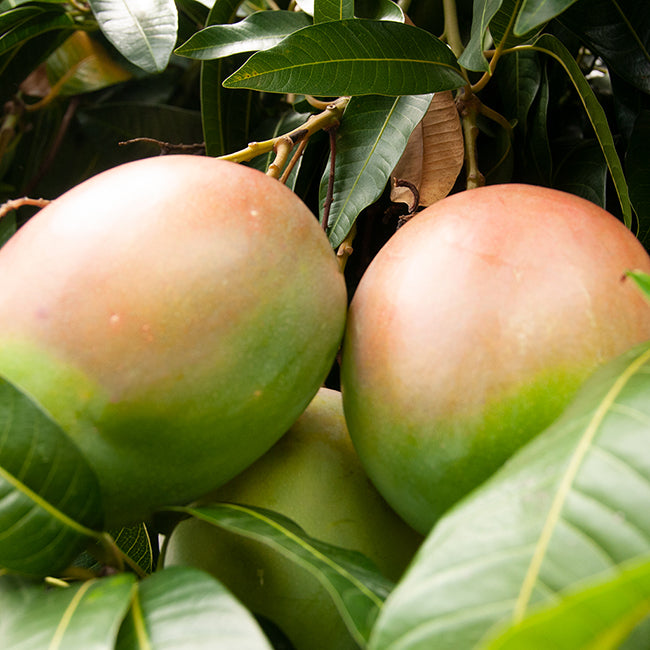
Guest post from Jenn Co
The following is an excerpt from Jenn Co's article on her time visiting Fruandes.
Having lived in Vancouver, Canada for a good chunk of my life, I would call myself extremely blessed. Immersed and surrounded by luxury and opportunity, it’s easy to forget there’s a whole other world out there. When I decided to step out of my comfort zone and embark on my first solo travel trip by heading to Colombia, I knew I was in for an adventure.
As I stood at the entrance to Fruandes, I couldn’t help but think, “This doesn’t look like a production warehouse.” It reminded me more of the outside of a house. I turned the handle, entered in and was immediately arrested by the sweet smell of deliciousness. I peeked past the staircase and saw crates upon crates of…mangoes! This must be heaven! I’m a mango monster, you see! I knew at that moment I was going to thoroughly enjoy this educational experience to its fullest.
Fruandes started as a dream. In 2002, the market value of coffee beans was plummeting and Level Ground saw a need to partner with small-scale rural Colombian farmers to diversify their offerings in order to survive. Fruit seemed to be the most logical solution as it grows well in Colombia’s rich tropical climate. Plus, the high altitudes and rich soil of the Andes provided the perfect conditions to high-growing fruit trees. This is how Fruandes dried fruit was born.
 |
 |
Fruandes, short for Frutos de los Andes (Fruit of the Andes), is a certified B-Company. B-companies use business to solve environmental and social issues. Fruandes exports its organic fair trade mango, pineapple, dragonfruit, golden berries, and bananas to many countries in the world—Canada, Sweden, Switzerland, Italy, Czech Republic, Chile, US and the Netherlands, to name a few. What’s incredibly inspiring about this story is… when Fruandes started, Colombian dried fruit didn’t even exist, much less exported! Now there are four other competitors in the market vying for people’s taste buds and loyalty. One could say Fruandes broke the ground in this area of business.
With all that knowledge in tow, I was raring to actually experience what happens in a dried-fruit production plant. But first things first: Get into gear! Jasmine, the packing supervisor, gave me a change of clothes: a loose white V-neck top and matching elasticized pants, a hair net, face mask, rubber boots and gloves. I was so excited to jump into doing things, Jasmine literally had to stop me. “Mira,” she said, which means “Look.”
Riiiiight. I needed to wash my hands and dip my rubber boots into a water bath. I soon discovered hand-washing was a crucial part to the entire operation. I literally had to do this before anything and everything. Let’s just say, Fruandes takes cleanliness and hygiene as top priority. The facility is both organic and on its way to meeting international standards for their processes.

Peeling, cutting and laying mangoes on drying racks
Once I was thoroughly clean, I walked through a plastic curtain and into the main facility. I slipped on a rubber apron and was directed to a long upright table where smiling women were peeling and cutting mangoes. A knife was handed to me and I proceeded to copy the technique of these expert cutters. It took a while to get the hang of it because the ripe mangoes kept slipping and sliding out of my hands. I was taught to distinguish which pieces were able to make it to the next round, and which needed to be separated. So anything bruised or squishy had to go. These pieces are usually given to the workers at the end of the day for them to enjoy or bring back to their families. The pieces that made the cut were then laid flat onto drying racks, after which they were popped into dehumidifying ovens where the mangoes reincarnate into their more dehydrated versions.

Once dried, the fruit goes through another round of inspection where the best of the best get sorted into big plastic bags. The bagged dried mangoes are sealed, boxed up, then brought upstairs where they are packaged and labeled.
Jasmine escorted me up a flight of stairs and directed me to the room where more ladies were busy filling and weighing small packets of dried fruit. The day I was there, they were working on dragonfruit. After washing my hands (See? What did I tell you?) and donning a fresh pair of gloves, Jasmine gave a quick explanation of how to weigh and seal the packets. Then away I went! With weighing scale on hand, I ensured each bag held the exact number of grams indicated by the packets. After doing a hundred of those (or so it seemed), I moved over to a nearby machine and ran the packets twice to ensure they were sealed entirely. The last step was combining a dozen of these small packets into a bigger bag, stuffing that into a box, taping it down, and getting it ready to be sent to the country that ordered it.
An important aspect of Fruandes is how the production process keeps more money within the country. By paying growers and producers fair trade prices and hiring Colombians to work in the factory plant, Fruandes is able to reinject finances back into the local economy. From its inception, when Fruandes director Giovanni Porras rented a small space in a low-income area, the story has been about making the lives of Colombians better.
In 2002, Giovanni installed a dehydrator and gave six marginalized women in the Cazuca refugee community work. These women along with their children were struggling to survive. Through a connection with a local NGO, the women and children now have minimum wages, access to healthcare, transport subsidies, school tuition, scholarships and materials. Today, there are more than 45 women employed by Fruandes during peak fruit processing periods. Level Ground receives around nine containers of their dried fruit and panela (cane sugar) a year. The other European and US markets receive just as much product, if not more. So even though Level Ground founded Fruandes, this dried fruit company has definitely grown beyond them!
- Jenn
